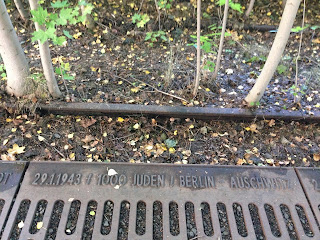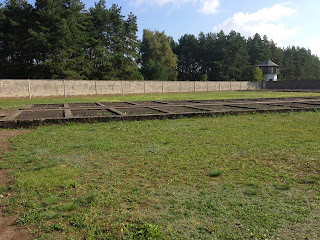Throughout Berlin there are many commemorative sites dedicated to the victims of National Socialism. There are so many you can literally stumble upon them. This museum is tucked away in what once was the thriving Jewish quarter of the city before the rise of Nazism. The museum is dedicated to Otto Weidt, the owner of a workshop for the deaf and blind. During the war years Weidt employed Jewish workers to prevent their deportation and produced brushes and brooms in the shop and today the museum is located in the old rooms of the workshop.
Friday, October 11, 2013
Gleis 17
My friends and I went to visit the memorial at the Grunewald rail station. Gleis 17 was the track used to transport most of Berlin's Jews to various destinations in the east after 1941. The station is located outside of the city center and came into use to hide the mass deportations from the rest of the populations.
Rough translation: "In remembrance of the 1941 - 1945 deportations by train to the death camps."
Along the platform were plaques with the date, number of people, and destination of each transport out of the Grunewald station between 1941 and 1945.
Unbekannt - Unknown
KZ Sachsenhausen
A few weeks ago I visited KZ Sachsenhausen, a Nazi concentration camp on the outskirts of Berlin. The camp was used by the Nazis from 1936 until the end of the war, at which time it became a Soviet camp for political prisoners (predominantly those who had committed war crimes during the Third Reich) until its closure in 1950. The camp was opened as a museum by the Soviets in the early 1960s, but the museum failed to commemorate the non-communist victims imprisoned there during the war years and instead commemorated the 'anti-fascist struggle' of the Soviet East against the Nazis. After German reunification the memorial was expanded to include all victims of the camp during World War II. Sachsenhausen was one of the earlier and smaller of the Nazi concentration camps and just to clarify, this camp was not an extermination camp. Although thousands of people died here, it was not established as a death camp as those in the East were. This is a very basic overview of the history of this camp.
I'm not sure one can write a response or reaction to visiting the camp. There are no words to accurately describe the feeling of being at a place like this and knowing what happened here. Besides, who am I to tell a story I will never understand? No words that you or I could ever come up with would do justice to the victims or survivors of any of the camps. So go listen to a survivor speak. They are the ones to tell these intimate stories.
So, in the absence of words, these are some images from the camp.
Subscribe to:
Comments (Atom)











































